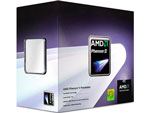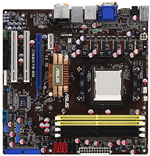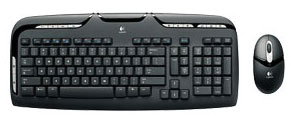AMD HTPC
Everyone asks for HTPC component recommendations, and then when we publish them readers can't wait to throw rocks at our recommendations. Perhaps this is because the HTPC, more than any other computer class, is a very personal machine. It needs to meet the specific needs and demands of the end users, who vary widely in what they plan to do with their new HTPC. So let's first talk about our concept in these two HTPC configurations.
We are assuming the user already has the HDTV (likely) or display he plans to feed, along with a sound system for that HDTV. The motherboards we recommend can reasonably feed audio signals for your Blu-ray movies, but they are not integrated audio amplifiers. Since most end-users are on cable or satellite for TV, we will make no recommendations at all for a TV tuner. Of the many possible uses of an HTPC the great majority of end-users store, play, and stream movies with their HTPC computers. That is mostly what their HTPC systems are used for and that is where we have concentrated our recommendations. In general the processing power in both systems has increased since our December 2009 guide, but costs have gone down a bit.
| AMD HTPC System | ||
| Hardware | Component | Price |
| Processor | MD Phenom II X3 710 (2.6GHzx3, 3x512KB L2, 6MB L3 Cache) |
$119 |
| Cooling | CPU Retail HSF | $- |
| Video | On-Board | $- |
| Motherboard | ASUS M3N78-EM | $90 |
| Memory | 4GB DDR2-800 - GSkill F2-6400CL5D-4GBPQ | $37 |
| Hard Drive | Western Digital Caviar Green WD10EACS 1TB SATA 3.0Gb/s Hard Drive - OEM | $105 |
| Optical Drive | LG BD/HD DVD / 16x DVD+/- RW GGC-H20L - Retail | $110 |
| Audio | On-Board | $- |
| Case | SILVERSTONE Black Aluminum/Steel LC13B-E ATX HTPC Case (After $15 Rebate) | $100 |
| Power Supply | PC Power & Cooling Silencer PPCS500 500W ATX12V / EPS12V SLI Ready CrossFire Ready 80 PLUS Certified Active PFC Power Supply - Retail (after $25 Rebate) | $50 |
| Base System Total | $611 | |
| Keyboard and Mouse | Logitech Cordless Desktop EX110 Black USB RF Wireless Keyboard & Optical Mouse | $30 |
| Operating System | Microsoft Vista Home Premium OEM | $99 |
| Complete System Bottom Line | $740 | |
 |
The CPU chosen for the AMD HTPC computer is the new triple core Phenom II X3 710 with 6MB of L3 cache. You get the expanded processing power of the Phenom II, which is always useful in an HTPC, at the same price as the older Phenom CPU chosen in the December guide. The three CPU cores each run at 2.6GHz, each with a 512KB cache, and a shared 6MB L3 cache - the same L3 cache sized shared on Phenom II quad-core processors. We hesitate to call a Phenom II X3 CPU a low-end chip, but this is certainly the most reasonable Phenom II you can buy. It has plenty of power, however, to drive your AMD HTPC to most anywhere you choose to go.
With DDR2-800 so reasonable these days we equipped the HTPC with 4GB of G.Skill memory. We aren't really interested in overclocking this HTPC (though it's technically still possible), and spending additional money on even higher performance RAM just doesn't make sense. 4GB of memory, however, does make perfect sense in an HTPC box.
 |
The $90 ASUS M3N78-EM is based on the NVIDIA GeForce 8300 chipset. The board features one PCI-E x16 slot, one PCI-E x1 slot, two PCI slots, 8GB memory support, NVIDIA Gigabit LAN, 7.1 HD audio, 12 USB ports, five 3Gb/s SATA ports with RAID support, IEEE 1394a, one eSATA port, HDMI/DVI/VGA output, and full support for the Phenom 140W processors. This board offers overclocking capabilities along with being a top notch HTPC capable board. We highly recommend the GF8200/8300 series for the HTPC market due to hardware accelerated Blu-ray/H.264 playback, multi-channel LPCM output, and very good application performance.
 |
As we discussed in the HTPC introduction, we did not include a TV tuner in the configuration since most end-users are now using their cable and satellite feeds. Few users, therefore, have any real need for a TV tuner card. There's something else to consider in this, and that is the US government mandated deadline to end analog broadcasts (which is now in June), so older/cheaper analog tuner cards are now useless unless you have an analog Cable/Satellite signal. If you truly need a Digital TV tuner, one option that is pretty unique on the TV tuner side is the HD HomeRun from Silicondust USA. This is a dual HDTV tuner/recorder that functions over a network and provides ATSC/QAM support. The price of $169 is more than many other options, but this is arguably a more flexible overall solution - particularly with the mandated move to digital and away from analog.
What's the point of having an HTPC if you don't have a lot of storage space? To that end, we selected a newly affordable 1TB (1000GB) Western Digital Caviar Green WD10EACS SATA hard drive at just $105. The WD Green is a variable speed energy saving design that we found to be among the quietest drives we have ever evaluated. For an HTPC, quiet operation is paramount and this WD Green will not disappoint. The WD Green is a bit slower than true 7200RPM 1TB drives, but the real performance difference is very minor. Another excellent HD option is the Seagate Barracuda 7200.11 ST31000333AS 7200RPM 1TB at $110. Performance of this 1TB drive has been exemplary in early testing at AnandTech, and the drive has proved to be reasonably quiet. Seagate also makes a super-reliable 1TB drive optimized for video storage and retrieval called the Seagate SV35.3 ST31000340SV 1TB at $150. This "video" Seagate features 24x7 reliability with > 1 million hours MTBF and improved read/write reliability. For those willing to pay the small premium the "video" Seagate would be a good alternate choice.
 |
The optical drive is certainly an upgrade to the entry and budget systems since a reasonable HTPC requires Blu-ray playback capabilities. The LG Black 6X Blu-ray SATA fits the bill without breaking the bank. It provides 6X Blu-ray playback and the fastest recording and playback of DVD and CD media. The current price is around $110, but this drive sometimes goes on sale for $100 so look out for specials. There are also Blu-ray options under $100 from Lite-On and a 6X Blu-ray player at $105. We do not have much experience with this Lite-On drive, but Lite-On drives in the past have proved reliable. That would make the Lite-On Black 6X Blu-ray SATA a more reasonably priced alternative where every penny counts.
 |
Our choice for an HTPC case is the audio component look in the Silverstone LC13B-E, which is an extremely flexible design with two silent fans and silent power when combined with the PC Power and Cooling 500W Silencer power supply. This solid Silverstone case can handle either ATX or Micro ATX motherboards, with space for four internal hard drives in addition to two 5.25" External bays and two 3.5" external bays. If your plans for your HTPC include lots of comportments and storage the Silverstone is an excellent choice. If you prefer a small cube case the Lian Li PC-V350B is a gem of a small black aluminum case. The Lian Li is our choice for the Intel HTPC system on the next page, and you can find more information on that case there.
 |
Since most will place their HTPC near their HDTV or big screen monitor, a wired keyboard and mouse are not really very useful in most setups. Control is more often from across the room, so a wireless RF Logitech keyboard and mouse were selected. At just $25 for the pair, the Logitech Cordless Desktop EX110 wireless keyboard and mouse is a great value. This is also the HTPC preferred RF wireless set, which does not require "line of sight" that is needed for IR wireless.
The final price of the AMD HTPC comes to just $740. That has to be considered a bargain considering the triple core Phenom II CPU, 4GB of memory, and 1TB hard drive all housed in a quiet Silverstone HTPC case with a PC Power and Cooling Silencer 500W PSU. You can certainly spend even less on a basic HTPC box, but we doubt you can build a more powerful or quiet system for the same money.










66 Comments
View All Comments
scwtlover - Monday, March 16, 2009 - link
Thanks. Do you have an opinion regarding the significance of voltage?Wesley Fink - Monday, March 16, 2009 - link
At the same speed or overclock lower voltages that actually work are always better. Higher voltage allows some incredible performance but high voltages shorten component life. If two memories are honestly rated at the same speed and timings but one is lower voltage at that speed, the low voltage is the better choice.There are fewer variations in memory speed, timings, and voltages than you might imagine, though. Almost every memory vendor buys memory chips on the open market. When one company stumbles onto a terrific new chip or PCB it isn't long until most of the major players have the same thing. Expertise in PCB design and SPD programming can matter in performance, but not nearly as much as the actual memory chip and binning used.
scwtlover - Tuesday, March 17, 2009 - link
I apologize for not asking my question more clearly. I understand your general point regarding lower voltages putting less stress on computer parts. I see, however, that while I can get quality 800 DDR2 RAM at 1.8 volts and CAS 5, to get quality 1066 DDR2 RAM at CAS 5, the RAM spec will be 2.0V or even higher. What considerations come into play in making this choice for an AMD system?erple2 - Tuesday, March 17, 2009 - link
By "incredible performance" do you mean that are visible in benchmarks only, or in real world usage?scwtlover - Monday, March 16, 2009 - link
After reading your praise of ASRock's 780GX board for the AMD entry-level system, I was surprised not to find it even mentioned for the AMD budget system. Currently, it's $5 less expensive than the Biostar board you do recommend. As I try to finalize components for my own new build, should I being drawing adverse conclusions about the ASRock 790GX board?MFK - Monday, March 16, 2009 - link
Whats the deal with those these days?I got a cable box for my cable signals but I need my HTPC to act as a DVR.
I think any HTPC should include a TIVO card. Doesn't have to be a TV tuner though!
What would be the cheapest way to add DVR functionality to the HTPCs in the article?
BernardP - Monday, March 16, 2009 - link
All the suggestions are nice and well-balanced. However, monitor choices on the entry-level systems seem questionable. Yes, you have to meet the price point, but these days, it seems 22-inch monitor have become the minimum worth spending money on. Spending on a brand-new 17-inch or 19-inch monitor seems a waste, unless someone has not enough space to fit a larger monitor.The0ne - Monday, March 16, 2009 - link
I agree. 22" LCDs have the sweet spot now. Even the 24"s are coming down in price.Spivonious - Monday, March 16, 2009 - link
Why no tuner in the HTPC? Also, since the 9400 chipset handles all decoding, why use a beefy processor? Also, a 500W power supply is way overkill. 350W would be plenty and probably quieter too.Save $30 on the CPU and go with the E1400.
Other than that, it looks almost exactly like the HTPC I spec'ed for myself last week, only to find out that my bonus was not very big after Uncle Sam got to it.
7Enigma - Monday, March 16, 2009 - link
Did you read the article? They gave an explaination (whether you agree with it or not):[quote]"Since most end-users are on cable or satellite for TV, we will make no recommendations at all for a TV tuner. Of the many possible uses of an HTPC the great majority of end-users store, play, and stream movies with their HTPC computers. That is mostly what their HTPC systems are used for and that is where we have concentrated our recommendations. In general the processing power in both systems has increased since our December 2009 guide, but costs have gone down a bit."
"As we discussed in the HTPC introduction, we did not include a TV tuner in the configuration since most end-users are now using their cable and satellite feeds. Few users, therefore, have any real need for a TV tuner card." [/quote]
As for the beefy processor I somewhat agree with you. If all you are doing is playing movies and such then a lowly cpu is all that is needed due to the mobo. But any form of heavy processing work such as encoding to highly compressed formats, or multitasking while watching a video and it makes sense. Having the better cpu certainly gives you the flexibility to do more than just watch movies.